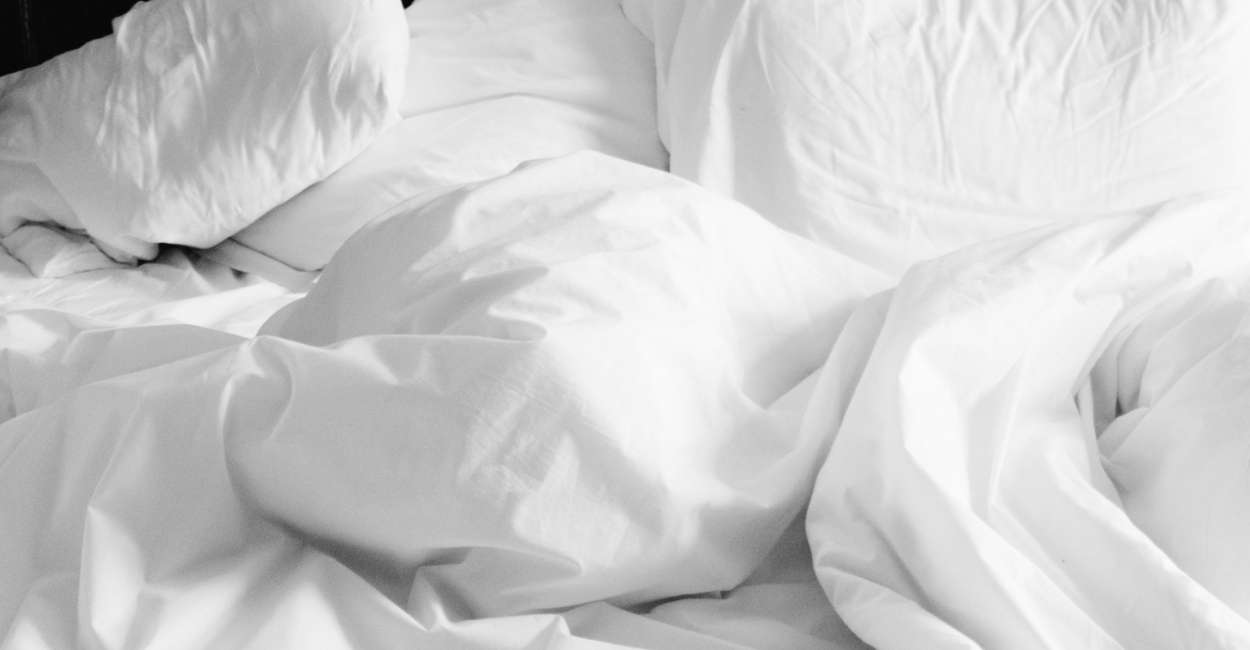One cozy and warm comforter can last you for all of eternity. It’s your best friend for winter nights… and if it’s versatile, you can love it even in summers. So, buying a comforter is no less than choosing an investment plan.
Moreover, the different options about the material, filling, stitch, and endless technology spin your head quite hard.
But here’s the good news: We’ll help you sort out all the confusion and help you find the comforter made just for you!
NOTE
We have enlisted our recommended comforters in this guide, here.
So, let’s begin the quest for comfort here…
Types of Comforters
If you have a grandparent, they can tell you a lot about how the stitch has a major impact on the comforter’s quality.
It might seem like random stitching for an external appearance, but it saves your comforter from clumping. So, let’s see which one will work best for you…
1. Baffle Box
This type of comforter stitching makes it the warmest. The duvet checkerboards have smaller fabric baffles. The stitch holds the fabric pieces but still gives it great loft. This is the most expensive type.
2. Quilt Stitching
This one externally appears like the checkerboard in a baffle box. But, no fabric strip reinforces the stitch. This is less expensive and usually seen in lower fill-power duvets.
3. Channel
There’s no checkerboard in this comforter. Instead, there are parallel seams or “channels” across it which lets the down/filling shift inside the comforter. This is great if you want to adjust the down over your body if you want less warmth. So, this is the best comforter for hot sleepers.
4. Gusset
This kind has fabric walls on the edge to increase the comforter height and loft. These have baffle stitches and are expensive but the warmth and coziness are totally worth it.
But the stitching isn’t the only important part, so let’s get down to details here…
What to consider before buying a comforter?
Your comforter will stay with you for life… well, at least for a decade… unless you want to splurge every season. So, you must always make sure what exactly suits your needs and tastes.
To help you find the best, here are some quick factors that you must consider.
1. Environment
A comforter always lies on your bed and can magnify the beauty of your room. Since you don’t put it away, its style must complement your bedroom aesthetic. If it’s for a child, different styles are available.
If you live in an area with extreme weather, you might need to buy two sets for summer and winter. Then get a vacuum seal bag to store the off-season one.
2. External fabric
Usually, the outer fabric of the comforter is made of cotton. Take note of the thread count (number of threads woven in a square inch fabric).
Higher thread count gives you softer and more comfortable material and helps keep the down better which increases its durability.
On average you don’t need a thread count of more than 300 if you wrap the comforter in a cover.
You can go as low as 230 or as high as 500 if you want to try out different lightweight models. Any higher than 500 might make the fabric extremely heavier.
Also look for extra benefits in the labels like “moisture wicking”, “advanced temperature regulation”, and “anti-microbial technology”.
Silk, cotton-polyester blend, and linen are also available as the alternative outer fabric.
3. Inner fill
a) Down
This is a highly breathable, light, yet warm filling. It’s the soft fluff of birds that keeps them warm in chilly seasons. Don’t confuse it with feathers as feathers don’t work well for insulation and are cheaper.
If a comforter is marked “down”, it has 30% down and 70% feathers, so go for ones with “100% down”, “pure down”, or “all down” marked. Remember that pure down will be much more expensive.
If you want the fluffiest kind, choose goose down over duck gown and be prepared to pay more for the popular variable.
Goose down usually comes from mature geese which have voluminous down clusters.
Duck down is great for warm weather and hot sleepers. Duck down is available both in white and gray colors.
But people demand white one more due to the color blending. So, it might be a bit more expensive than the gray ones even though both give you the same experience.
If you’re allergic to many things, get one with cleaned and sterilized down to get rid of most allergens.
b) Alternatives
If you want a hypoallergenic fill, get synthetic materials like polyester, rayon, cotton, or wool filling comforters. They’re much less expensive than pure down but also less breathable and heavier kinds.
Another popular microfiber blend is PrimaLoft. It feels just like white goose down. It has a warmth level of goose down 550 fill power. It’s hydrophobic, so it dries easily.
4. Fill features
a) Fill power
This refers to the down fluff or how much space an ounce of down occupies and is usually labeled on the package. Higher fill power implies better down quality, i.e., thicker and high insulation of the comforter. Depending on the weather and your needs the powers mean these:
400 and below: Perfect for summers and hot regions as these are lightweight. These breathable types help hot sleepers avoid overheating from extra weight
400-600: Works in any weather as they keep you warm in winters and cool in summers. These midweight and versatile types are suitable for a minimalist lifestyle as they decrease your clutter and save your space.
600-800: Suitable for winters and colder areas. 650+ is the best for frosty nights.
800 and above: Gives extra warmth for cold sleepers
b) Fill weight
This is the ounce of the down present in a comforter. Usually, a high fill power down has a low fill weight which makes the comforter lighter than usual and suitable for hot weather. The perfect balance between fill weight and fill power allows you to feel neither too hot nor too cold.
5. Size
Like beds, comforters are also available in:
- Colossal King: 120 × 120 inches
- Oversized King: 106 × 96 to 108 × 98 inches
- King: 102 × 86 to 104 × 96 inches
- Colossal Queen: 110 × 110 inches
- Oversized Queen: 90 × 96 to 90 × 98 inches
- Queen: 88 × 88 to 92 × 92 inches
- Full/Double: 82 × 90 to 86 × 92 inches
- Twin XL: 66 × 90 to 68 × 92 inches
- Twin: 66 × 86 × 68 to 68 × 88 inches
Measure your bed from the floor surface of one side to another across the mattress top. Don’t add any inches over that so your comforter won’t touch the floor when you sleep.
Depending on your bed and bed skirt, you might need to adjust the size.
If you use an extra deep mattress, mattress toppers, or you share a queen-sized bed, choose an oversized queen or king-size comforter.
But if you’re confused between the battle of comforter vs duvet, let’s know how they differ here…
How to choose between a duvet or comforter?
Many brands use the terms comforters and duvets interchangeably because you can use a duvet cover for both, both come with down and alternative filling. However there are subtle differences, so let’s know what are comforters and duvets in a glance…
1. Duvets are usually white. Comforters are available in colors and patterns
2. Duvet covers are a must for duvets, not for comforters.
Ready to find a new comforter? Can’t decide where to get it? Let’s check which one is better here…
Where to buy a Comforter?
You’re all set to invest in a new comforter and have a pretty good idea of your required features… but you’re confused about whether you’ll get your dream comforter in a store down the road or online.
Well, to get the best product, let’s sum up your probable experience here…
1. In-store shopping
If you like being old-school, this might be your best bet as you can peacefully choose after seeing the product up close. So, let’s keep a few details in mind…
Pros
In a physical store, you can look, feel, and visually compare the selections. You can pick peacefully if you want something specific or want to make sure of the supreme quality.
Tips
Measure the needed size of the comforter to save yourself from multiple visits to the store.
2. Online shopping
If you’re too lazy to visit the stores or aren’t ready to pay more for brick-and-mortar stores, read on to be more aware…
Pros
You get infinite options in one click. You can scroll, compare, and combine features like size, texture, color, fabric, pattern, fill power, fill weight, and construction.
Tips
Always double-check for return policies. If they charge you for returning the items, consider other options.
Curious how much you need to spend to buy a good comforter? Let’s check the range here…
What is the average cost of a Comforter?
Comforter price depends on variables like material, size, and fill power. A good comforter might be available from $80 to $500+ depending on different factors.
Down comforters are more expensive than down alternative comforters. Goose down is costlier than duck down.
You can get comforters for cheaper, but they won’t last you long, have cheap materials, the sewing may come off, and the filling might clump quickly.
The deals may seem attractive, but you might need to buy more frequently. An inexpensive one might even impact your health and quality of sleep. So, it’s better to invest more in a trusted brand for once than spending on local ones repeatedly.
Curious when you can avail the steal deals on comforters? The right time awaits you here…
When to buy a Comforter?
Down comforters can last you for 10 years at least and even more if you care for them properly. Get a new comforter when your comforter loft loses the fluffiness or feels flat and unevenly lumped up.
Notice the condition of your comforter at the end of winter. If you need a new one, you’ll get great discounts or late-winter or early-spring sales.
You might even notice price drops after New Year’s. Most brands offer a traditional “white sale”. Otherwise, buy before October because from October to February, products go out of stock from the high demand.
Some retailers even offer holiday sales, so sign up for their emails to get a promotional reminder. Don’t forget to look out for manufacturer-direct prices, promo codes, and overstock sale products.
Can’t decide on one product? Consider a few ideas here…
What Comforter Should You Buy? – Our Top Recommendations
Though your comforter purchase is a personal matter, we hope you’ll choose nothing but the best. But the definition of best depends on your needs. So, don’t take our recommendations too strictly and know about the best comforter sets for a rough idea…
1. Rayon from Bamboo Duvet Set
This product is woven from the rayon of soft bamboo fibers which is suitable for sensitive skin.
Why it is on our list?
- 8 corner and side loops help secure the duvet cover
- Natural, breathable, and hypoallergenic
- Wicks away moisture from the body
- 30-day return policy
- Free refund
- Available in King and Queen
- Colors available: white, rain, driftwood, citron, and ash
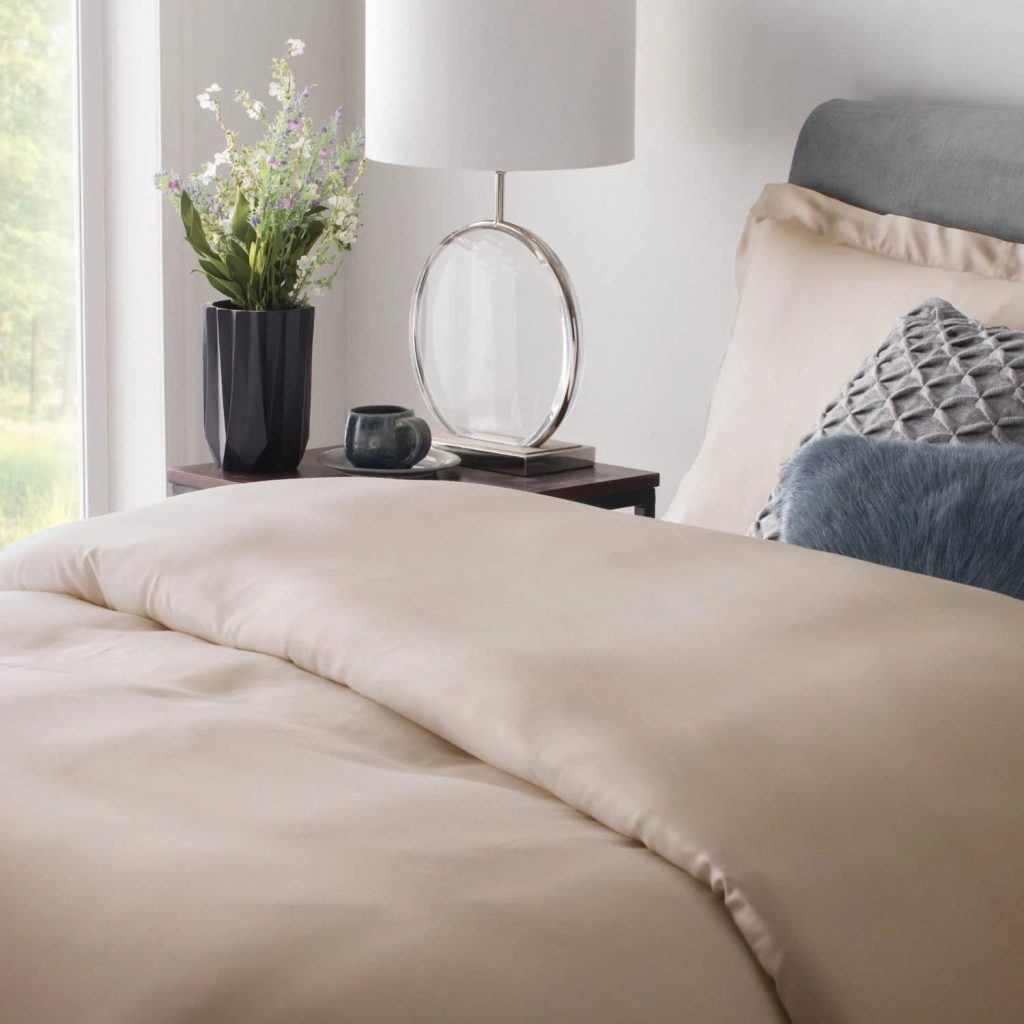
2. Sateen White Goose Down Comforter
This is a fluffy and warm comforter and fits all weathers. The loft and weight feel luxurious and are covered with a satin-like cotton sateen breathable material.
Why it is on our list?
- 100% goose down filling (European White Goose)
- 700 fill power gives lightweight warmth
- 330 thread count on 100% cotton sateen cover
- Responsible Down Standard (RDS) certified
- Breathable, wicks moisture, regulates temperature
- Box stitch gives great loft and evenly warms
- Double stitch and German piping increases durability
- Corner loop ties are attached to secure the duvet cover
- Available in Twin, Queen, and King
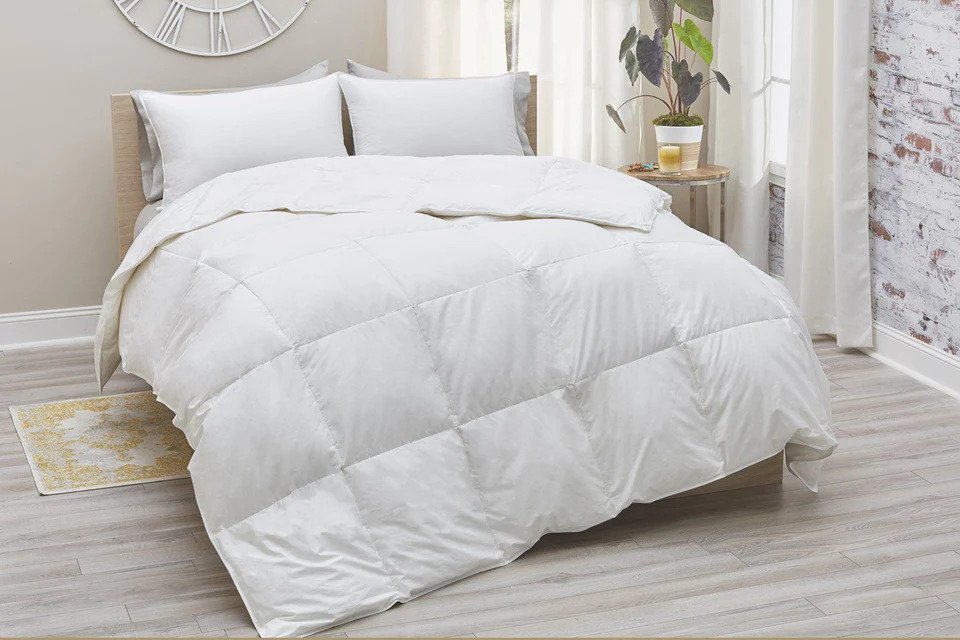
3. Down Alternative Microfiber Comforter
It’s as soft as a down comforter but uses completely down-free filling. It has a high fill power and is lightweight
Why it is on our list?
- Great vegan down alternative: fine and silky microfiber polyester fill
- Brushed ultra-soft microfiber cover
- Hypoallergenic and moisture wicking
- Box stitches for breathability and lofty feel
- It has ties to secure the duvet cover
- Durable double-stitched edges
- Easy to care for, can be machine-washed, dryer-friendly
- Fits all mattress depth
- Available in Twin, Full, Queen, Oversized Queen, King, Oversized King, California King
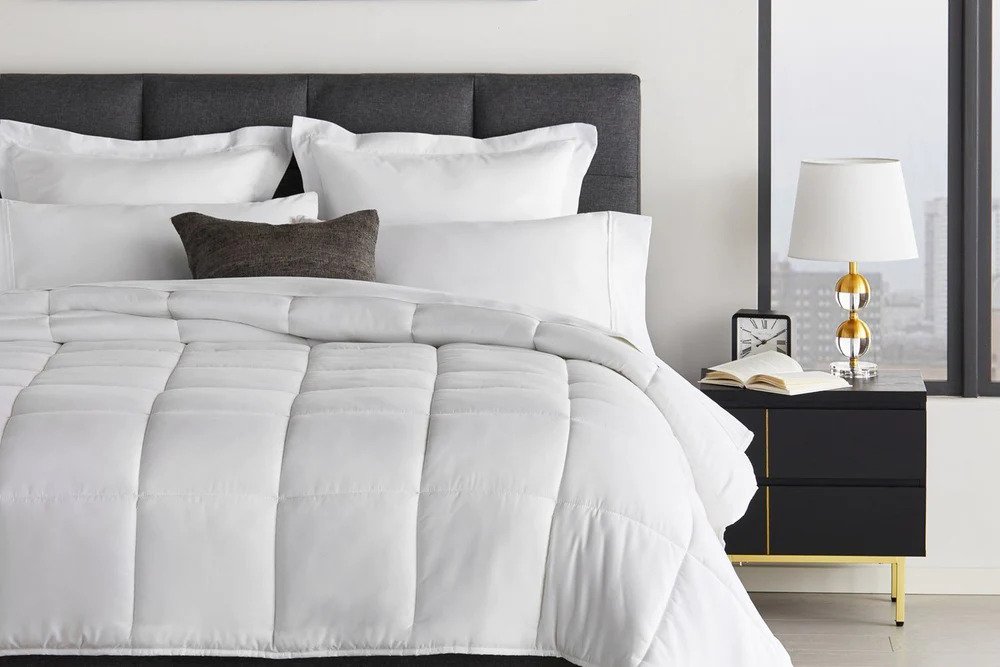
4. Nolah Bamboo Comforter
This is a lightweight yet luxurious-looking comforter that keeps you cozy and resists overheating. The bamboo feels extremely silky on the body.
Why it is on our list?
- Effortless and free shipping
- Extremely soft bamboo
- FSC Certification warrants natural, eco-friendly, sustainable, and antibacterial properties
- Highly breathable
- Built-in temperature regulating technology
- Moisture wicking
- Hypoallergenic and resists odor
- 10-year warranty
- Oeko-Tex 100 warrants no harmful toxins, chemicals, or dyes
- Available in Twin, Twin XL, Full, Queen, King, and California King with tie loops to secure your duvet covers.
- 120-night free trial
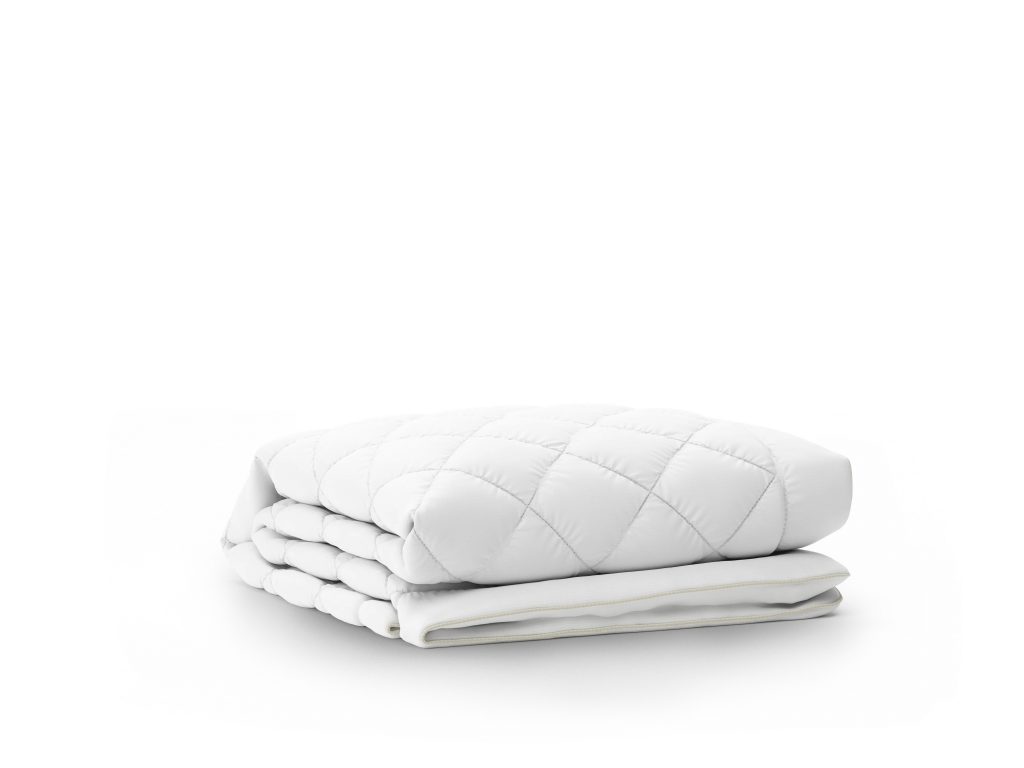
But before you buy a new one, think again… can you fix it somehow? Let’s know if that’s possible here…
When to replace a comforter?
A quality comforter lasts you around 10-25 years. But, if your duvet is still in good shape but you want a change, don’t throw away the poor baby.
Try to replace or add small parts to make it work for a lower price than buying a whole new comforter.
If it’s because the style doesn’t match your bedroom aesthetics, pick a duvet comforter of suitable color, pattern, and style and even look for a set with matching pillow shams.
If your comforter isn’t fluffy anymore or lost some filling, buy some filling, stuff it, and sew it up. You might need $20 for a quarter pound of down filling and your sewing techniques.
Alternatively, if you don’t have time or skills, you can get it done by a professional and still save your bucks.
Final Statement
The lifetime of a comforter also depends on how you treat it. Look closely at the cleaning labels and choose wisely. Try to avoid spot-cleaning ones as you can’t clean them comfortably.
If it’s a machine washable one, make sure you keep it in the front load and go for gentle washing. Don’t let any detergent sit and let it dry liberally.
Treat your comforter gently and it’ll comfort you for a long time.
